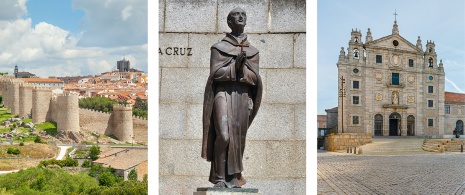
Discover Spain’s most famous pilgrimage routes
When we talk about pilgrimages in Spain, the first that comes to mind is the famous Camino de Santiago, or Way of Saint James, and all the possible routes leading to the great Santiago de Compostela Cathedral. And no wonder! However, there are a host of other religious sites awaiting you here, as rewarding to visit as the pilgrims’ ways that will lead you to them.
Debe activar Javascript para poder utilizar este servicio
-
The Way of Saint James
St James’ Way is an unforgettable adventure, a challenge to overcome, a whirlwind of new experiences, an internal journey that marks a before and an after. And the most important pilgrims’ route in Spain. Three of its most travelled routes are the French Way, the Northern Way and the Original Way. The French Way, or the Camino Francés, is the most popular, as it connects with other routes and is also the longest. If you want to get started on this route from the Spanish side, the most common departure points are Somport (Aragon) or Roncesvalles (Navarra), though both options join up at Logroño. If you prefer to take the Northern Way, or the Camino del Norte, you’ll be setting off from the city of San Sebastián, while the Original Way (Camino Primitivo) begins at Oviedo Cathedral. Whichever starting point you choose, the route will take you through a series of wonderful stages, all with the same destination: the promised Santiago de Compostela Cathedral.
-

The Ruta Mariana
The Ruta Mariana, or ‘Marian Route’, is the result of the pilgrims’ desire to follow in the footsteps of the Virgin Mary. It is split into five stages that bring together the principal shrines dedicated to the Virgin Mary: Meritxell, Montserrat, El Pilar, Torreciudad and Lourdes. This route attracts great numbers of devotees of the Blessed Virgin, though it is also popular with lovers of culture and art who enjoy visiting its various shrines, basilicas and hermitages.One of the most acclaimed stops on this route is Christianity’s very first Marian church: the Basilica of Nuestra Señora Del Pilar. This is an impressive Baroque building in the centre of Zaragoza. Inside, you can take a close-up look at frescos by Goya, as well as the majestic Santa Capilla, home to an effigy of Our Lady of the Pillar, Patron of the Hispanic World. But your visit doesn’t have to end here. Imagine climbing to the highest point of its towers to admire the church from above, together with some sensational views of the River Ebro and the historic city centre.Your next stop could be the Sanctuary of Torreciudad, in Ribagorza, Huesca. The church sits atop a cliff and looks out over El Grado reservoir. This is a place with natural vistas guaranteed to take your breath away, where you can enjoy total peace.You can end (or begin) the Ruta Mariana at the Benedictine monastery of Montserrat (Barcelona), a religious sanctuary that welcomes hundreds of pilgrims over the course of the year. Inside, under the care of the monastery’s monks, you’ll find the Basilica of the Virgin of Montserrat.
-

The Ruta Teresiana
The Ruta Teresiana (or the Teresian Route) invites you to walk through sites that were significant in the life of Saint Teresa of Jesus and Saint John of the Cross. This time, your journey will start off in Ávila, the city of Saint Teresa’s birth. If you enjoy rural tourism, one of the sites you might want to make a stop at is Fontiveros, a town of rustic façades where Saint John of the Cross was born. You’ll also pass through Duruelo, where both saints founded the first Discalced (barefoot) Carmelite monastery. The pilgrimage comes to an end in Alba de Tormes, the village in which Saint Theresa died.This route is not just a spiritual journey to a real destination, it is also an opportunity to discover another world through the culture, nature, and folklore of the places you pass through along the way.
Travel plans for inspiring you







